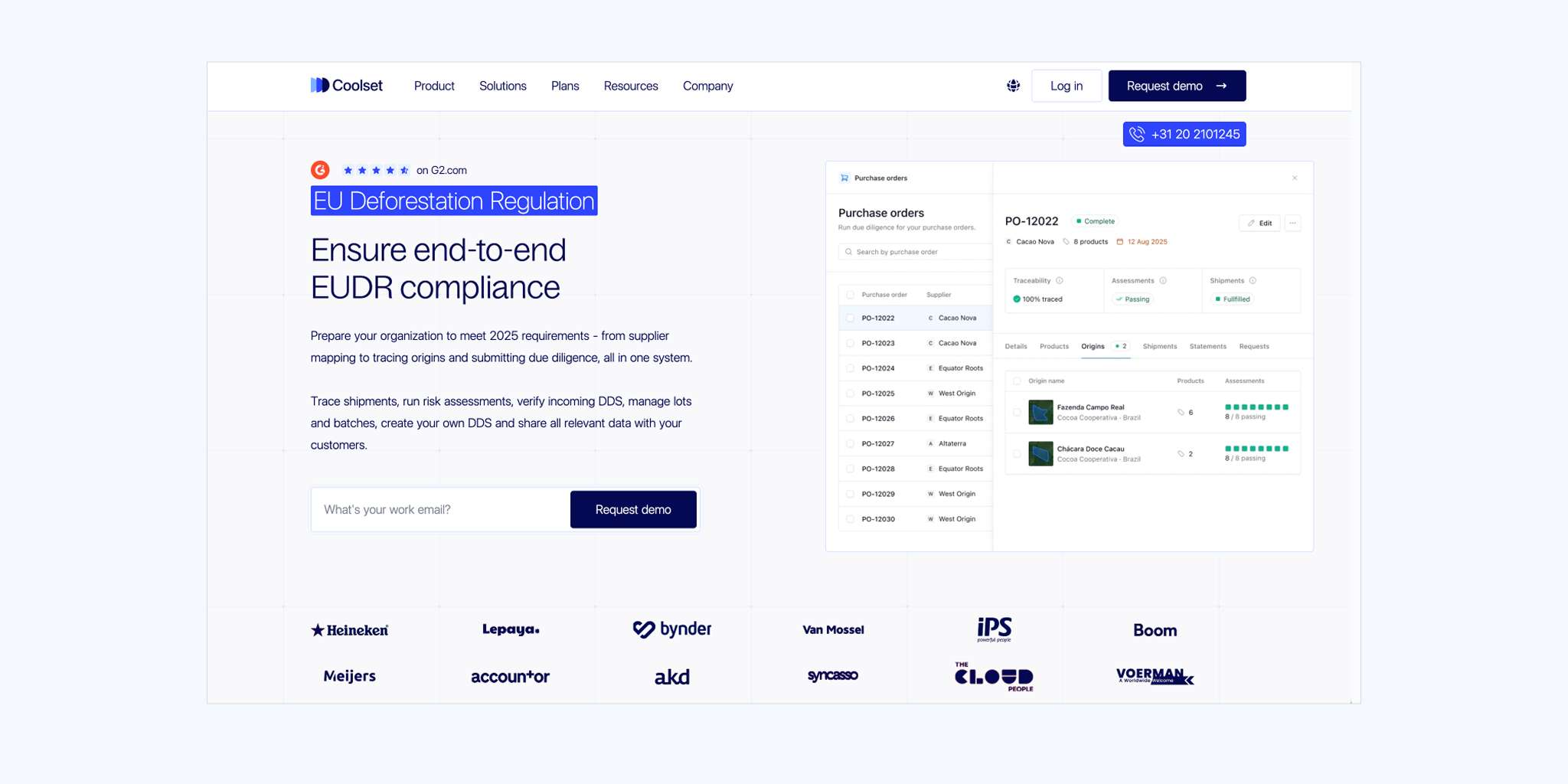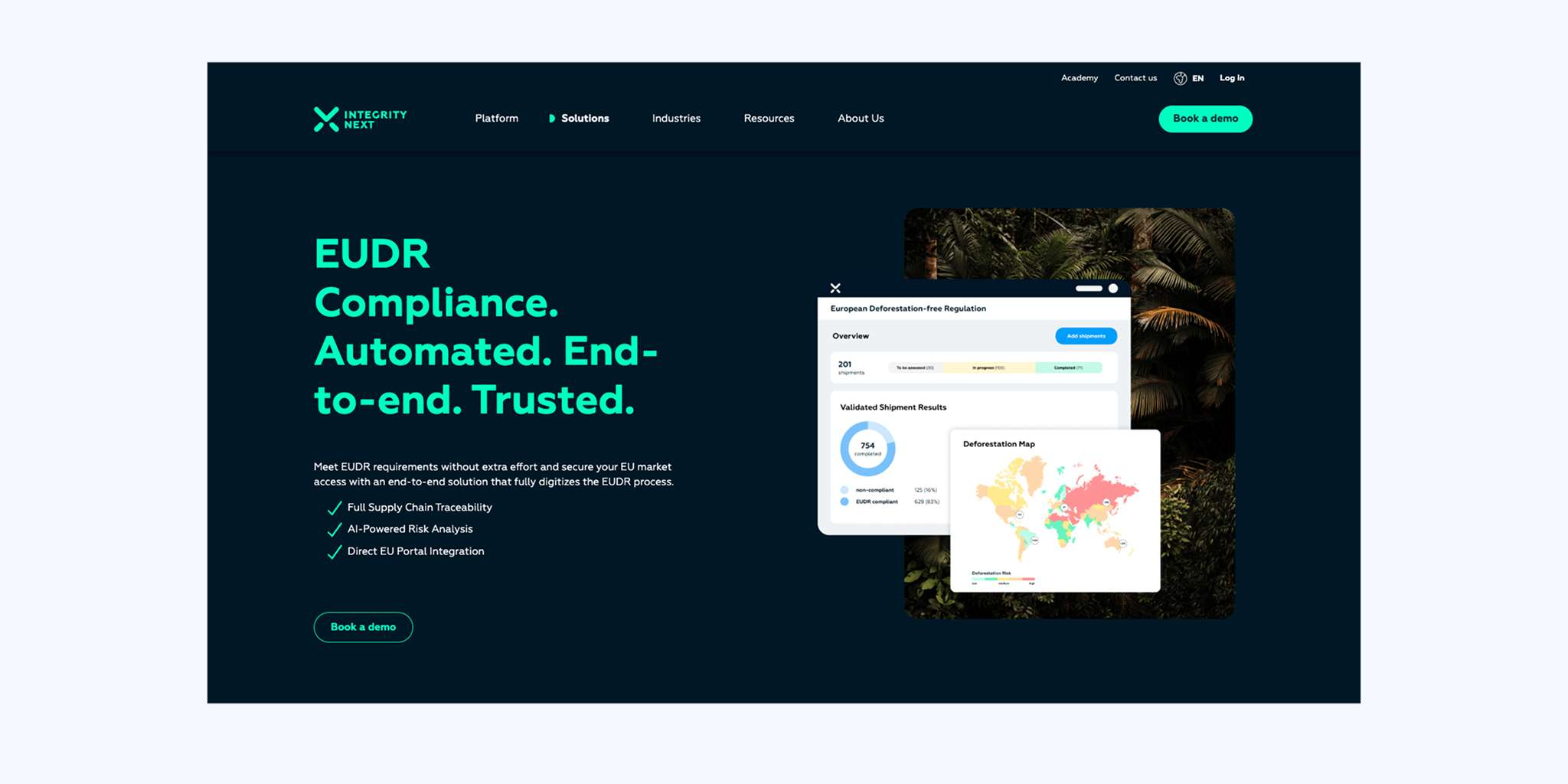Disclaimer: Latest EUDR developments
On 21 October, the European Commission proposed targeted changes to the EU Deforestation Regulation (EUDR). These adjustments aim to make the rollout smoother without changing the regulation’s overall goals.
Key points from the proposal:
We're closely monitoring the development and will update our content accordingly. In the meantime, read the full explainer here.
The EU Deforestation Regulation (EUDR) EUDR timeline may be under discussion, but the requirement to comply isn’t going anywhere. ESG, compliance, procurement, and legal leads all face the same challenge: proving that every shipment of forest-risk commodities entering the EU is fully traceable and deforestation-free.
For mid-market importers, that pressure shows up everywhere. Think gathering geolocation data from suppliers who may not be prepared, auditing high-risk origins, validating polygons, managing huge volumes of documentation, all while keeping up with a regulation that is still evolving.
The clock is ticking, resources are stretched, and the workflow complexity is only increasing.
This is where EUDR compliance tools become essential. Instead of scrambling across spreadsheets, emails, and PDF evidence, dedicated platforms help you centralize supplier data, automate risk scoring, identify gaps, and prepare for audits with far less manual lift.
Many companies start their search with TradeAware, or are already using it, but now have open questions:
If you’re evaluating TradeAware or looking for alternatives that fit your supplier ecosystem, risk profile, and budget, this guide will help. Below, we break down the top five TradeAware alternatives for EUDR compliance in 2025, including where each tool shines, how they differ, and why some may be a better fit for mid-market, compliance-first teams like yours.
LiveEO’s TradeAware platform is built specifically for EUDR compliance, combining satellite imagery, AI-driven deforestation assessment, and legal verification workflows aligned with Articles 9–11 of the regulation.
It’s designed to plug into complex enterprise systems, support high-volume supplier networks, and offer detailed geospatial analysis that helps large organizations validate risk with precision.
For companies with intricate supply chains and strong internal IT support, TradeAware can be a powerful fit, especially when advanced integrations and granular monitoring are essential.
But if you’re a mid-market importer with simpler workflows, fewer technical resources, or suppliers who aren’t yet comfortable with geolocation-heavy processes, this level of complexity can feel heavy. It’s a sophisticated tool, but not always the most practical or cost-effective choice for smaller, compliance-first teams.
Many teams start with TradeAware on their shortlist, but quickly realize the platform may not be the best operational fit. The combination of satellite analytics, legal verification workflows, and deep systems integration often requires a larger budget and longer implementation timeline than mid-market importers can justify.
Supplier readiness is another major factor. If your suppliers are still early in their EUDR journey, struggling with geolocation data, documentation, or digitization in general, you may need a tool that offers simpler onboarding and clearer guidance rather than a complex geospatial workflow.
There’s also the cost-benefit question. All importers must meet EUDR’s geolocation and satellite-based verification requirements, even in low-risk countries, but not everyone needs the level of advanced deforestation analytics that TradeAware specialises in.
For many companies, the real priority is speed and usability: onboarding suppliers, validating risk quickly, and generating defensible audit evidence. In those cases, a simpler, compliance-first platform often delivers better ROI.
Finally, team size matters. Smaller compliance or procurement teams usually work best with platforms that come with built-in workflows, fewer customizations, and a clearer “do this next” structure. For these organizations, TradeAware can feel like more tools than they need, prompting the search for alternatives that match their reality.
Use this checklist to evaluate whether a platform is the right fit for your supply chain, team, and compliance maturity:
Now that we know what to look out for, let’s take a look at five TradeAware alternatives that may be better suited to your business’s needs.
Best for fast, structured EUDR compliance
With Coolset, compliance and supply-chain teams can manage their entire EUDR workflow in one place. That means no spreadsheets, no manual DDS templates, and no custom internal tooling.

The platform makes it easy to connect shipments to supplier-provided GPS coordinates, harvest dates, and HS codes; assess deforestation and legality risks using satellite imagery; and submit DDS files directly to TRACES with full audit history.
And yes, while we’re the authors of this guide, we genuinely believe Coolset is the most practical option for mid-market companies that need to get EUDR-ready quickly and without heavy IT resources.
Website: www.coolset.com/eudr
Best for: Mid-market traders, operators, and manufacturers that need a clean, efficient path to EUDR compliance, without hiring a full ESG team or building custom workflows.
Standout features:
Limitations: Coolset doesn’t offer in-house consulting, but it partners with trusted advisory firms for compliance and supply-chain guidance.
{{product-tour-injectable}}
Best for blockchain-backed, first-mile traceability
BanQu offers a traceability system built on blockchain, giving companies a tamper-proof way to verify where their products come from, a key requirement under the EUDR.

The platform links brands, traders, and suppliers through a shared digital record, capturing plot geolocation, legality documents, and chain-of-custody data via mobile tools and ERP integrations.
Website: www.banqu.co/eudr
Best for: Organizations sourcing from smallholders or higher-risk regions that need verified, first-mile data and a transparent, end-to-end audit trail.
Standout features:
Limitations: BanQu can require more setup and resources than some mid-market teams expect, especially if your suppliers are already digitized and you’re looking for a lighter, faster-to-deploy solution
Best for deep, multi-tier traceability with broad regulatory support
Sourcemap is designed for companies that need full visibility across complex supply chains, from raw material origins to final shipment. Its platform enables detailed supplier mapping, plot-level geolocation, shipment traceability, and automated workflows that support EUDR compliance, including TRACES submissions.

Website: sourcemap.com/solutions/eudr
Best for: Importers, manufacturers, and traders operating in high-risk or highly layered supply chains.
Standout features:
Limitations: Sourcemap’s feature depth is extensive, but it can feel heavy for mid-market teams that need something simpler and faster to configure.
Best for enterprise-scale automation with AI and a massive supplier network
IntegrityNext provides a highly automated compliance platform built to support large organizations working across complex, multi-tier supply chains.

Its EUDR offering combines AI-driven risk analysis, satellite-enabled geolocation checks, and access to a global network of more than two million suppliers, making it well suited for high-volume operations that need robust, scalable processes.
Website: integritynext.com/esg-solutions/eudr-deforestation-regulation
Best for: Enterprises or large importers with broad supplier ecosystems, significant trade volumes, and a need for highly automated, end-to-end EUDR workflows.
Standout features:
Limitations: Its wide reach and automation capabilities can be overkill for smaller or mid-market teams that want a more streamlined, easier-to-configure platform.
Best for ready-made, end-to-end EUDR compliance
osapiens provides a full EUDR workflow out of the box, from supplier onboarding and document collection to geolocation mapping and risk assessment. It’s built for companies that want broad regulatory coverage without assembling multiple tools themselves.

Website: osapiens.com/solutions/eudr
Best for: Importers or manufacturers that need a structured, all-in-one compliance platform with broader ESG coverage.
Standout features:
Limitations:
The platform’s breadth can exceed what smaller or mid-market teams need, especially if they want a more lightweight, faster-to-deploy solution.
The right EUDR platform depends less on flashy features and more on what your team can realistically implement before the 2025 deadline. If you’re managing a large, global supply chain with strong internal IT and compliance resources, TradeAware remains a solid enterprise option.
If you’re a mid-market importer with lighter integration needs and limited internal support, a more streamlined platform like Coolset will likely get you compliant faster and with far less friction.
Use the checklist in section 3 to assess each tool against your actual operations: supplier readiness, budget, team size, risk appetite, and how much complexity you can support. The “best” solution isn’t necessarily the most advanced one, it’s the one your suppliers can use, your team can maintain, and you can fully operationalize in time.
{{custom-cta}}
EUDR compliance marks a major operational shift, and choosing the right platform is ultimately about finding the best fit for your team, not the tool with the longest feature list.
TradeAware delivers strong geospatial analytics and legal workflows, but its complexity and setup requirements may exceed what mid-market teams need, especially when speed and supplier adoption matter most.
The alternatives highlighted in this guide, including Coolset, offer different strengths that favor practicality, faster onboarding, and clearer workflows. As you evaluate your options, focus on your internal readiness, the maturity of your supplier network, and your overall risk profile.
The right tool is the one your team can actually implement, manage, and trust to get you fully compliant by the December 30, 2025 deadline.
Map suppliers, trace origins, run risk assessments and submit due diligence in one connected system.
